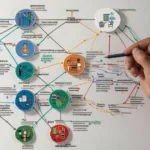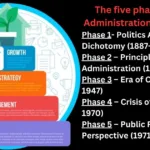New Public Administration has emerged as a concept, signifying a paradigm shift in the field of public administration in recent years. This revolutionary approach to governance has transformed traditional governance models, addressing the challenges and limitations they often face. In this blog post, we will explore the emergence and evolution of New Public Administration, its key features, and its goals and objectives. By understanding these aspects, we can uncover the potential of this new approach in shaping a more effective and responsive public sector.
Meaning of New Public Administration:
The New Public Administration (NPA) refers to a movement and a theoretical framework that emerged in the field of public administration in the late 20th century. It represented a departure from traditional approaches to public management and governance. The core ideas and principles of New Public Administration include:
1. Focus on People: NPA emphasized the importance of serving the needs and interests of citizens. It advocated for greater responsiveness, accountability, and transparency in public administration.
2. Efficiency and Effectiveness: NPA sought to improve the efficiency and effectiveness of public services through modern management techniques, such as performance measurement, strategic planning, and outcome-based evaluation.
3. Ethical Considerations: NPA emphasized ethical principles and values in public administration, including integrity, fairness, and social justice. It aimed to ensure that public administrators uphold high ethical standards in their decision-making and conduct.
4. Democratic Governance: NPA promoted democratic governance by advocating for citizen participation, decentralization, and empowerment. It emphasized the importance of involving citizens in decision-making processes and fostering collaboration between government agencies, civil society organizations, and the private sector.
5. Innovation and Adaptation: NPA encouraged innovation and flexibility in public administration to address complex and dynamic challenges. It recognized the need for public organizations to adapt to changing circumstances and adopt new approaches to problem-solving.
Overall, New Public Administration represented a shift towards a more citizen-centered, accountable, and responsive model of public governance, aiming to improve the quality of public services and strengthen democratic institutions.
Definitions of New Public Administration:
Here are some definitions of New Public Administration:
1. Fred Riggs’ Definition: Fred Riggs, a prominent scholar, defined New Public Administration as an approach that emphasizes efficiency, economy, and effectiveness in public administration. He highlighted the need for professionalism and expertise in managing public affairs.
2. Dwight Waldo’s Definition: Dwight Waldo, another influential figure in public administration, described New Public Administration as a movement that seeks to humanize bureaucracy. He emphasized the importance of ethical considerations, social equity, and responsiveness to citizens’ needs.
3. Frank Marini’s Definition: Frank Marini contributed to the understanding of New Public Administration by defining it as an approach focused on participatory decision-making, decentralization, and empowerment of local communities. He emphasized the role of citizens in shaping public policies and programs.
4. Charles Levine’s Definition: Charles Levine characterized New Public Administration as an effort to reform bureaucratic structures and processes to enhance accountability, transparency, and responsiveness.
He advocated for greater citizen engagement and the use of modern management techniques in public sector organizations.
5. Kenneth Kernaghan and David Siegel’s Definition: Kernaghan and Siegel described New Public Administration as a movement that emphasizes the importance of democratic values, social justice, and citizen participation in governance.
They highlighted the need for public administrators to adopt a more collaborative and inclusive approach to decision-making.
These definitions represent different perspectives on New Public Administration, reflecting its multifaceted nature and evolving interpretations over time.
The Emergence of New Public Administration
Before delving into the specifics, let’s first understand the context in which New Public Administration has emerged.
Traditional governance models have often relied heavily on bureaucratic structures and hierarchies, which can hinder innovation, efficiency, and citizen-centric decision-making. Recognizing these limitations, the need for a new approach became increasingly evident.
Understanding Traditional Governance Models
Traditional governance models, characterized by centralized decision-making and bureaucratic red tape, have played a significant role in shaping public administration. However, these models often struggle to adapt to complex societal challenges and meet the evolving needs of citizens. The rigid hierarchies and lengthy processes can impede effective service delivery and hinder responsiveness.
The Need for Change: Challenges and Limitations
The need for change in public administration arises from the challenges and limitations posed by traditional models.
These challenges include slow decision-making processes, lack of transparency, and insufficient citizen engagement.
Additionally, the ever-increasing demand for effective and efficient public services necessitates a new approach that can overcome these obstacles.
Evolution of New Public Administration

The evolution of New Public Administration can be traced through various transformative changes that have taken place in recent years. Let’s explore these changes and their impact on governance. Let’s delve into each of these conferences and their significance in the development of New Public Administration:
1. Honey Report 1967 of New Public Administration:
- The Honey Report, also known as the Report of the Study of the Administration of Justice, was a seminal document in the field of public administration.
- Published in 1967, it was led by John C. Honey, commissioned by the American Society for Public Administration (ASPA).
- The report critiqued the traditional model of public administration, which focused on efficiency and effectiveness, and advocated for a more humanistic approach.
- It emphasized the importance of addressing social equity, citizen participation, and responsiveness to societal needs in public administration.
- The Honey Report laid the foundation for the emergence of New Public Administration as a theoretical framework for public administration scholars and practitioners.
2. Philadelphia Conference – 1967:
- The Philadelphia Conference, held in 1967, was organized by the American Society for Public Administration (ASPA) and marked a pivotal moment in the development of New Public Administration.
- Building upon the ideas presented in the Honey Report, this conference brought together scholars and practitioners to discuss the need for a more socially conscious and responsive approach to public administration.
- It highlighted the importance of incorporating values such as social justice, equality, and citizen participation into public administration theory and practice.
- The Philadelphia Conference served as a platform for advancing the principles of New Public Administration and sparked further dialogue and research in the field.
3. The 1st Minnowbrook Conference 1968:
- The first Minnowbrook Conference, held in 1968, was a gathering of prominent scholars in public administration.
- It took place at the Minnowbrook Conference Center in New York and focused on reevaluating the goals and methods of public administration in the context of societal changes.
- The conference challenged the traditional model of public administration and called for a more humanistic and participatory approach.
- Discussions at the conference laid the groundwork for the development of New Public Administration, emphasizing the importance of social equity, citizen engagement, and organizational responsiveness.
4. The 2nd Minnowbrook Conference – September 4, 1988:
- The second Minnowbrook Conference, held in 1988, revisited the themes of the original conference in light of new challenges facing public administration.
- It brought together scholars from around the world to discuss issues such as globalization, technological advancements, and the changing role of government.
- The conference emphasized the need for public administration to adapt to evolving societal dynamics while remaining true to the core values of democracy, social equity, and accountability.
- Participants reaffirmed the principles of New Public Administration and explored innovative approaches to addressing contemporary governance challenges.
- 3rd Minnowbrook Conference – September 3 – 7, 2008:
- The third Minnowbrook Conference, held in 2008, continued the tradition of examining the state of public administration and charting its future direction.
- It focused on issues such as governance in the digital age, collaborative governance, and public service leadership.
- The conference provided a platform for scholars, practitioners, and policymakers to exchange ideas and explore strategies for enhancing the effectiveness and responsiveness of public administration in a rapidly changing world.
- Discussions at the conference reflected the ongoing relevance of New Public Administration principles in guiding public sector reforms and promoting democratic governance.
These conferences played a crucial role in shaping the evolution of New Public Administration as a theoretical framework and influencing the practice of public administration worldwide.
They provided platforms for scholars and practitioners to engage in critical dialogue, exchange ideas, and advance the principles of democratic governance, social equity, and citizen participation in public administration.
Reimagining Governance: Transformative Strategies in New Public Administration
1. Breaking Down Bureaucratic Structures
One of the fundamental shifts in New Public Administration is the breaking down of bureaucratic structures.
This is achieved through the decentralization of decision-making processes, which flattens hierarchies and empowers frontline workers.
By distributing decision-making authority, organizations can better respond to the needs of citizens and adapt to changing circumstances.
2. Flattening Hierarchies: The Shift towards Decentralization
Flattening hierarchies is a key aspect of New Public Administration. By moving away from top-down decision-making, organizations can tap into the expertise and insights of employees at all levels.
This empowers employees to take ownership of their work, fosters innovation, and enhances responsiveness.
3. Embracing Transparency and Accountability
New Public Administration emphasizes transparency and accountability as essential principles.
By embracing these values, organizations can cultivate public trust and ensure responsible decision-making.
Through transparent processes, citizens can have a clear understanding of how policies are formulated and executed, fostering a sense of ownership and participation.
4. Streamlining Processes: Efficiency and Effectiveness
Streamlining processes is central to the success of New Public Administration.
By eliminating unnecessary bureaucratic procedures and optimizing workflows, organizations can enhance efficiency and effectiveness.
This allows for faster service delivery, reduced costs, and improved outcomes for citizens.
5. Embracing Technological Advancements
Technological advancements have played a transformative role in shaping New Public Administration. Let’s explore some key aspects of this transformation.
6. Digital Transformation: From Paper to Bytes
The digitization of processes has revolutionized the way public administration operates.
By transitioning from paper-based systems to digital platforms, organizations can streamline workflows, reduce paperwork, and enhance accessibility.
This not only saves time and resources but also enables seamless collaboration among different stakeholders.
7. Leveraging Data and Analytics for Evidence-Based Decision-Making
Data and analytics have emerged as powerful tools in New Public Administration. By leveraging data from various sources, organizations can gain valuable insights into citizen needs and preferences.
This facilitates evidence-based decision-making, enabling governments to allocate resources efficiently and design policies that better serve their constituents.
8. Enhancing Citizen Engagement and Participation
Technology has also opened up new avenues for citizen engagement and participation. Through online platforms, citizens can actively contribute to policy-making processes, provide feedback, and voice their concerns.
This two-way communication promotes a sense of ownership and strengthens the bond between the government and its citizens.
9. Emphasis on Results and Outcomes
In contrast to traditional models that often focus on processes, New Public Administration emphasizes results and outcomes as the ultimate measures of success. Let’s explore this further.
10. Outcome-Focused Public Service Delivery
New Public Administration shifts the focus from inputs to outcomes in public service delivery. By aligning resources and efforts toward achieving specific goals, organizations can maximize the impact of their programs.
This outcome-focused approach ensures that public resources are used effectively and that citizens receive the intended benefits.
11. Performance Management: Setting Clear Goals and Objectives
Setting clear goals and objectives is crucial in New Public Administration. By defining measurable targets and monitoring performance, organizations can assess their progress and make necessary adjustments. This enhances accountability and enables continuous improvement.
12. Continuous Evaluation and Learning
New Public Administration emphasizes continuous evaluation and learning to drive innovation and improvement.
By regularly assessing the effectiveness of policies and programs, organizations can identify areas for enhancement and adapt to changing circumstances.
This iterative approach ensures that public administration remains agile and responsive to citizen needs.
Key Features of New Public Administration

New Public Administration is characterized by several key features that distinguish it from traditional governance models. Let’s explore these features in detail.
1. Collaborative Governance
Collaborative governance is at the core of New Public Administration, enabling collective problem-solving and decision-making.
This approach involves partnerships between the public sector, private sector, and civil society to unlock synergistic opportunities.
2. Public-Private Partnerships: Unlocking Synergistic Opportunities
Public-private partnerships (PPPs) have emerged as a crucial strategy in New Public Administration. By leveraging the strengths of both sectors, governments can deliver efficient and innovative services. PPPs foster collaboration, share risks and resources, and enhance service quality.
3. Networked Governance: Cross-Sector Collaboration
Networked governance is another key aspect of New Public Administration. This approach encourages cross-sector collaboration, bringing together different stakeholders to address complex societal challenges.
By breaking silos and promoting collaboration, networked governance unlocks the potential for interdisciplinary solutions.
4. Citizen Co-production: Harnessing Public Expertise
Engaging citizens in the co-production of public services is a hallmark of New Public Administration. By harnessing the expertise and insights of citizens, governments can design and deliver services that meet their specific needs.
Citizen co-production fosters a sense of ownership, increases service quality, and enhances public trust.
5. Integrating Ethics and Values
New Public Administration places a strong emphasis on integrating ethics and values into governance practices. Let’s explore this aspect further.
6. Promoting Integrity and Anti-corruption Measures
Integrity and anti-corruption measures are vital components of New Public Administration.
By promoting ethical conduct and establishing robust anti-corruption mechanisms, organizations can build trust among citizens and ensure responsible use of public resources.
7. Ensuring Equity and Social Inclusion
New Public Administration strives for equity and social inclusion, ensuring that public services are accessible to all citizens. By recognizing and addressing the needs of marginalized groups, governments can create a more inclusive and fair society.
8. Sustainability and Environmental Responsibility
Sustainability and environmental responsibility are key considerations in New Public Administration. By incorporating sustainable practices and addressing environmental challenges, governments can contribute to the well-being of current and future generations.
9. Adaptive and Agile Decision Making
New Public Administration embraces adaptive and agile decision-making processes to navigate uncertainty and complexity. Let’s explore this further.
10. Flexibility in Policy Design and Implementation
Flexibility in policy design and implementation is crucial in New Public Administration. By adapting policies to changing circumstances and societal needs, governments can ensure their relevance and effectiveness.
11. Responsive Governance: Navigating Uncertainty and Complexity
Responsive governance enables governments to navigate uncertainty and complexity effectively. By closely monitoring societal trends, engaging in continuous dialogue with citizens, and remaining receptive to feedback, organizations can make informed decisions in a rapidly changing world.
12. Embracing Innovation and Experimentation
Innovation and experimentation are central to New Public Administration. By embracing new ideas, technologies, and approaches, organizations can find creative solutions to complex problems. This culture of experimentation encourages learning and drives continuous improvement.
Goals and Objectives of New Public Administration

New Public Administration aims to achieve a set of goals and objectives that contribute to effective and responsive governance. Let’s explore these goals.
1. Enhancing Citizen Trust and Confidence
One of the primary goals of New Public Administration is to enhance citizen trust and confidence in the public sector. Let’s explore some strategies to achieve this goal.
2. Building Transparent and Accountable Institutions
Building transparent and accountable institutions is key to gaining citizen trust. By ensuring that decision-making processes are transparent, citizens can have confidence in the integrity of their government.
Accountability mechanisms, such as regular reporting and independent audits, further bolster trust.
3. Ensuring Accessible and Responsive Service Delivery
New Public Administration aims to ensure accessible and responsive service delivery. By providing timely and user-friendly services, governments can meet the diverse needs of citizens. Accessibility and responsiveness are crucial in fostering trust and satisfaction among citizens.
4. Fostering Public Participation and Civic Engagement
Public participation and civic engagement are central to New Public Administration. By actively involving citizens in decision-making processes, governments can ensure that policies and services reflect their needs.
This participatory approach strengthens citizen ownership and fosters a sense of shared responsibility.
5. Promoting Good Governance Principles
New Public Administration promotes good governance principles that underpin the functioning of the public sector. Let’s explore these principles further.
6. Strengthening the Rule of Law and Human Rights
Strengthening the rule of law and protecting human rights are fundamental aspects of New Public Administration.
By upholding legal principles and safeguarding the rights of citizens, governments can build a just and equitable society.
7. Reducing Corruption and Improving Ethics
New Public Administration aims to reduce corruption and improve ethical standards within the public sector.
By implementing robust anti-corruption measures, governments can ensure responsible use of public resources and maintain public trust.
8. Ensuring Equity, Fairness, and Social Justice
New Public Administration promotes equity, fairness, and social justice as core principles. By addressing social inequities and ensuring equal access to opportunities, governments can create a more inclusive and just society.
9. Catalyzing Effective Policy Implementation
Effective policy implementation is a key objective of New Public Administration. Let’s explore strategies to achieve this objective.
10. Achieving Development Goals and Sustainable Development
New Public Administration aims to achieve development goals and contribute to sustainable development.
By aligning policies with the Sustainable Development Goals (SDGs), governments can address pressing socio-economic and environmental challenges.
11. Facilitating Innovation and Adaptation to Change
Facilitating innovation and adaptation to change is crucial in New Public Administration. By fostering a culture of innovation, governments can identify novel approaches to address complex problems and adapt to evolving circumstances.
12. Maximizing Efficiency and Cost-effectiveness
Maximizing efficiency and cost-effectiveness is a key objective of New Public Administration. By optimizing resource allocation, eliminating waste, and implementing sound financial management practices, governments can achieve more with limited resources.
People Also Read: Good Governance: A Powerful Guide
Conclusion
In conclusion, the unveiling of a New Public Administration represents a revolution in governance. The evolution of this approach, characterized by breaking down bureaucratic structures, embracing technological advancements, and emphasizing collaboration, has the potential to transform the public sector.
By integrating ethics, adapting to changing circumstances, and focusing on achieving results, New Public Administration can foster citizen trust, promote good governance principles, and catalyze effective policy implementation.
This emerging approach holds great promise in unlocking the full potential of governance, driving innovation, and ensuring the well-being of societies.
Summary:
New Public Administration represents a paradigm shift in governance, addressing the limitations of traditional models.
By embracing collaborative governance, integrating ethics and values, and enabling adaptive decision-making, this approach aims to enhance citizen trust, promote good governance, and catalyze effective policy implementation.
With a focus on achieving results and outcomes, New Public Administration has the potential to revolutionize the public sector and deliver citizen-centric services.
FAQs:
Q: 1. What is New Public Administration?
A: New Public Administration is a revolutionary approach to governance that aims to overcome the limitations of traditional models. It emphasizes collaborative governance, integration of ethics and values, and adaptive decision-making.
Q: 2. How does the New Public Administration differ from traditional governance models?
A: New Public Administration differs from traditional models by flattening hierarchies, embracing technological advancements, and focusing on achieving results and outcomes. It also promotes collaborative governance, integrates ethics, and encourages adaptive decision-making.
Q: 3. What are the goals of the New Public Administration?
A: The goals of the New Public Administration include enhancing citizen trust and confidence, promoting good governance principles, and catalyzing effective policy implementation. These goals aim to foster a responsive and citizen-centric public sector.
Q: 4. How does the New Public Administration enhance citizen engagement?
A: New Public Administration enhances citizen engagement by promoting public participation, embracing citizen co-production, and leveraging technology to enable two-way communication between the government and its citizens.
Q: 5. What is the role of technology in New Public Administration?
A: Technology plays a crucial role in New Public Administration. It enables digital transformation, and data-driven decision-making, and enhances citizen engagement. Technology also facilitates efficiency, transparency, and accountability in public service delivery.
Q: 6. How does the New Public Administration address societal challenges?
A: New Public Administration addresses societal challenges by embracing collaborative governance, integrating ethics and values, and promoting adaptive decision-making. It also emphasizes outcomes and results, ensuring that policies and services effectively address complex societal issues.
Q: 7. How does the New Public Administration contribute to sustainable development?
A: New Public Administration contributes to sustainable development by aligning policies with the Sustainable Development Goals (SDGs), improving environmental responsibility, and promoting equity and social inclusion











